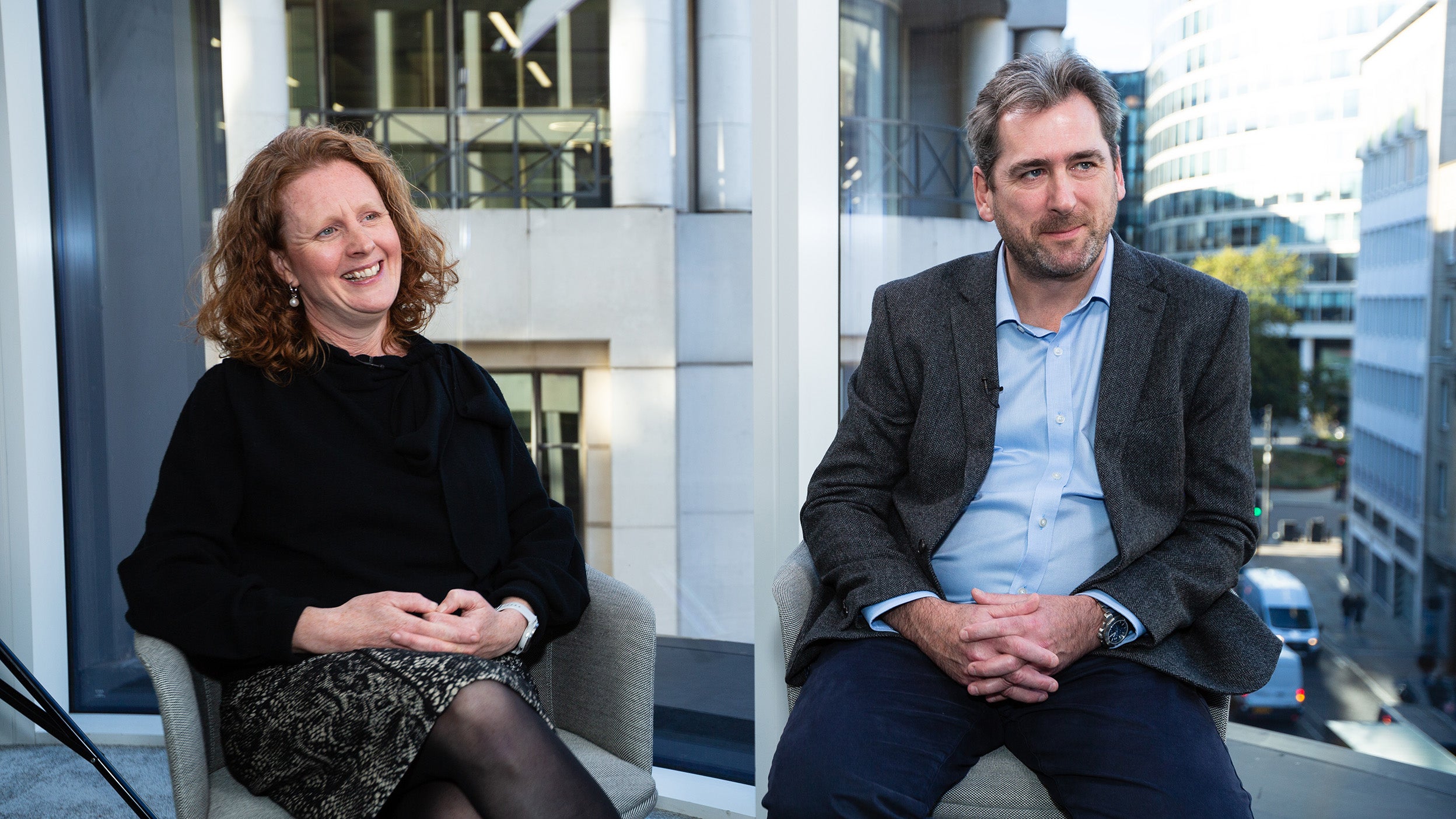
Key takeaways from our 2026 annual investment outlook webinar
Experts from equities, fixed income, real estate, alternatives, and more discuss where they see opportunities and risks in 2026.
David Aujla narration:
Hello, and welcome to the November 2025 monthly market update. My name's David Aujla, and I'm the lead portfolio manager for Invesco’s Summit Multi-asset fund ranges and its model portfolio service.
After seven months of positive global equity, November proved to be a much more nuanced month for global markets, with equities essentially treading water to end the month flat, but with winners and losers beneath the surface.
So, looking globally: Value outperformed growth. Small and mid-caps outperformed large caps, and eight of the 11 equity sectors were up for the month. It was the relatively large technology sector that was the weakest, acting as a drag on overall returns. Healthcare was the strongest sector, and while there may arguably be a bit less uncertainty around the sector, not much seems to have changed from a fundamental perspective. More so, maybe a rotation out of technology into reasonably valued defensive or perceived defensive sectors.
Regionally, emerging markets underperformed their developed market counterparts. But even there, we saw winners and losers. Emerging Asia, which tends to dominate the emerging market index, disappointed and ended the month down partly due to AI fears and a stronger U.S. dollar, but also those lingering policy concerns around trade. Latin American stocks, however, benefited from strength seen in commodity markets, and they ended the month up around 5 or 6%, depending on whether you're a US dollar or a sterling-based investor.
Even in developed markets, strong returns were pretty hard to find. The better-performing European and UK stock markets were up by around 1% and 0.5% respectively during the month, European stocks benefiting from good banks earnings in particular. In the U.S., we saw the government shutdown end, positive earnings announced across sectors of various industries not just the Magnificent Seven and some easing concerns over an AI bubble towards the end of the month, admittedly a volatile one. Despite that, the market there was flat, but as I alluded to earlier, there was meaningful sector rotation beneath the surface.
Developed Asia was down for reasons similar to those that emerged in Asia. Japan varied depending on which index you looked at. The price-weighted Nikkei 225 index was influenced by a small number of tech stocks, which were down, but the broader TOPIX index was up marginally. So maybe not hugely surprising to see some volatility in Japan after last month, which was its best monthly return in more than three decades, and also given rising tensions with China and the related headlines there around travel and import restrictions.
Fixed income overall fared better than equities, but the difference was marginal in terms of divergence between fixed-income markets. It was nothing like what we saw in the equity space. In fact, you could pretty much throw a blanket over the returns of global government bonds, investment-grade bonds, high-yield credit, and emerging-market bonds. Returns from November were all around sort of 0.5 percentage points from each other. The key driver, of course, was higher hopes for interest rate cuts, and as a result, shorter-dated bonds generally outperformed their longer-dated peers.
At the moment, markets see little to no ECB rate cuts ahead in the next 12 months, while it seems to be pricing in more meaningful cuts as you'd expect for both the U.S. Federal Reserve and the Bank of England. Interestingly, it appears to price in more cuts for the former than for the latter, which I think might remain to be seen, given what may be rolling out from UK inflation numbers and, of course, the energy package that comes into effect in January.
The UK budget at the end of November was of course the major event for us here in the UK, at least in terms of news flow. The Chancellor used improved forecasts to carve out some additional fiscal wiggle-room, which seemed to be to the liking of Gilt markets and, of course, Sterling. Most major tax and spending decisions, however, seem deferred to future years, many beyond the next general election. It turns out that income taxes may not have really been on the table after all, as I alluded to in my last video.
Looking to 2025 so far, it’s worth noting that the Magnificent Seven have delivered really strong returns; they're not actually among the top 10 highest returning S&P 500 stocks year to date something I think many would find surprising. And while the U.S. market itself has been very strong in a broad sense in local currency terms, UK investors would still have achieved higher returns from owning UK assets, European and Japanese indices in sterling terms this year. A reminder, perhaps, of the value of a well-diversified portfolio.
Looking forward, as you've heard from me before, I truly believe it's worth having the tools within your arsenal to adjust your portfolio. I think it might be as much about what you own within asset classes as how much you have of each.
Thank you for the time you've spent listening to this month's review. Of course, if you have any questions, let us know, but I hope you have a wonderful Christmas and get the chance to rest a well-earned rest and spend time with your nearest and dearest. Hopefully, markets are of the same mind and give us some calm over the next few weeks. If you have questions, as I said, let us know; but if not, I'll see you next time.
Disclosures (not being read, only showing up on screen):
Investment risks
The value of investments and any income will fluctuate (this may partly be the result of exchange rate fluctuations) and investors may not get back the full amount invested.
Important information
Data as at 05 December 2025.
This is marketing material and not financial advice. It is not intended as a recommendation to buy or sell any particular asset class, security or strategy. Regulatory requirements that require impartiality of investment/investment strategy recommendations are therefore not applicable nor are any prohibitions to trade before publication.
Views and opinions are based on current market conditions and are subject to change.
EMEA5028471/2025
In this monthly series, David Aujla recaps some of the key drivers impacting the markets. Sharing the thinking from our investment desks and research teams to help you guide your clients.
November marked a pause after seven months of positive global equity returns, with markets broadly flat but notable shifts beneath the surface. Value stocks outperformed growth, and small and mid-caps beat large caps. Healthcare led sector gains, while information technology lagged, acting as a drag on overall returns.
Regionally, emerging markets underperformed developed markets. Asia fell, pressured by a stronger US dollar and trade policy concerns, while Latin America benefited from commodity strength, rising 5–6%. Developed markets offered modest gains, with Europe up around 1% and the UK about 0.5%. US equities were flat despite positive earnings, the end of the government shutdown, and easing AI bubble fears, though sector rotation was evident. Developed Asia was mixed: Japan’s Nikkei dipped while the broader Topix edged higher amid volatility and geopolitical tensions.
Fixed income slightly outperformed equities, with returns across government, investment grade, high yield, and emerging market bonds clustered within half a percentage point. Hopes for rate cuts drove shorter-dated bonds higher. Markets currently price meaningful cuts for the US Federal Reserve and Bank of England, but little for the ECB. UK inflation trends and January’s energy package could influence expectations.
The UK budget was a key domestic event, with improved forecasts creating fiscal flexibility that supported Gilts and Sterling. Major tax and spending decisions were largely deferred beyond the next election.
Year-to-date, while the “Magnificent 7” delivered strong returns, they were not among the top 10 S&P 500 performers. In Sterling terms, UK, European, and Japanese equities have outpaced US equities, underscoring the importance of diversification. Looking ahead, adaptability and careful selection within asset classes will be critical.
By incorporating equities, fixed income, cash, and alternative asset classes, our multi-asset solutions are designed to solve complex challenges.

Experts from equities, fixed income, real estate, alternatives, and more discuss where they see opportunities and risks in 2026.

We see an overall constructive market backdrop with easing inflation and softer growth in the medium term, amid policy shifts and global uncertainties.

We are proud to announce our partnership with Zopa Bank, designed to make our professionally managed Invesco Summit Responsible Range more accessible to digitally savvy individual investors.